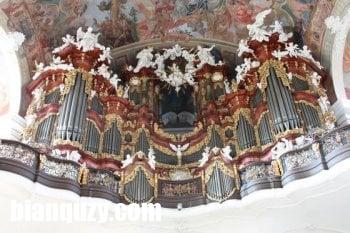 P2P | 30 October 2021 | 11.33 GB
P2P | 30 October 2021 | 11.33 GB
该乐器由迈克尔·恩格勒于 1732-1737 年制造。西里西亚管风琴的代表性乐器有 3 个手册和一个踏板,总共 50 个音级。 Positiv 占据最低的手动位置,放置在栏杆的两个小箱子中。一个箱子专用于风箱的 C 部分,另一个则用于 D 部分。 Hauptwerk(第 2 手册)和 Oberwerk(第 3 手册)和踏板位于主箱中,主箱横跨教堂中殿的整个宽度。 Oberwerk 占据表壳中央,Hauptwerk 在 Oberwerk 的左右两侧分为 C 侧和 D 侧,Pedal 位于两侧的塔楼和风琴箱的背面。这三个部门可能出人意料地位于同一水平面上,尽管这种设计在当时的西里西亚(和德国中部)管风琴建筑中相当普遍。 “工作原理”并没有被放弃,而是被重组了。也许,这种设计的总体思路是实现更均匀的声音。
该乐器具有西里西亚器官的典型特征。丰富的全宗,供应充足的等分停止,由具有梯级等级的混合物加冕。手册上有两个起伏停止(Vox humana 和 Unda maris)。手册中的簧片数量很少,但它们为踏板提供了强大的基础,从 Posaune 32′ 开始。乐器全合唱的响度由一侧的 Hauptwerk 的 16′ 基本音(HW 上有三个 16′ 音位)决定,另一侧由 8(或 12 个,如果耦合)混合音阶决定声谱。声音圆润柔和。手动簧片的颜色是特定的。小号柔软,几乎像双簧管,而 Positiv 簧片的音色类似于稍厚的 Regal。弦乐的广泛使用(Gamba、Salicional、Traveur)也是东方风琴制造传统的标志。
Krzeszow 保留了一个技术特性:Positiv 的键盘是可移动的,允许向下移调整个音调,从而允许 Positiv 在 Kammerton 与该时期的其他“室内”乐器一起使用。除了 Positiv 移调之外,还有 4 个踏板停顿可能会在 Kammerton 中发声。
在 1873-1874 年,Schlag 对该乐器进行了部分重建,改动主要影响了调音台(引入了 Barker 机器等),但幸运的是,只有少数声部被移除或改变了声音。 Positiv 失去了它的等分试样,Hauptwerk 在一个新的风箱上又获得了两个簧片挡位,Pedal 中的几个挡位进行了调整。
2005 年,修复委员会决定让乐器恢复到迈克尔·恩格勒的原始状态。修复工作由来自德累斯顿的风琴制造商 Jehmlich 于 2006-2008 年完成。结果,该乐器现在具有与迈克尔·恩格勒 (Michael Engler) 在 18 世纪完成时相同的构图。
它可能是保存最完好的迈克尔·恩格勒(Michael Engler)的乐器,实际上是迄今为止唯一保存完好的乐器,这一事实突显了该乐器的价值。另一个现存的风琴制造商的大型乐器,奥洛穆茨的圣莫里茨风琴(建于 1745 年),在 20 世纪的过程中进行了广泛的修改。
这是仅包含前置立体声通道的湿版
无噪声样本(键和寄存器敲击)
环境:
在 Hauptwerk \ 文件夹 HauptwerkSampleSetsAndComponents 中回复文件夹 OrganDefinitions 和 OrganInstallationPackages ,
或选择下载分发的文件夹(最终文件夹)以避免复制
注意力!为使键盘上键的声音正确,必须将 Pitch 菜单设置为 Equal tempament
或从音高菜单加载任何气质文件 – 加载气质
此外,还为管风琴添加了几个传输(即从另一个键盘借用)寄存器。这些
寄存器不占用内存,也没有图形化的可点击界面,
但可以分配给 MIDI 开关、MIDI 音符和电脑键盘
在列表中,此类寄存器被指定为 TransStop
TransStop rp Quintadena 16 (hw)
TransStop rp Unda maris 8 (hw)
TransStop rp Nachthorn 4 (hw)
TransStop hw Trompet 8 (ow)
TransStop ow Burdonflaut 16 (hw)
TransStop ow Unda maris 8 (hw)
TransStop ped Rohrflaut 4 (ow )
TransStop ped Flaut minor 2 (ow)
TransStop ped Trompet 4 (ow)
The instrument was built in 1732-1737 by Michael Engler. A representative instrument of the Silesian organbuilding has 3 manuals and a pedal, alltogether 50 stops. The Positiv occupies the lowest manual and is positioned in two small cases in the balustrade. One case is dedicated for the C part of the windchest the other for the D part. Hauptwerk (2nd manual) and Oberwerk (3rd manual) and the Pedal are located in the main case which spans wide through the full width of the church nave. The Oberwerk occupies the center of the case, Hauptwerk is divided into the C and D side to the left and to the right of the Oberwerk, and the Pedal is located in the two side towers and at the back of the organ case. All the three divisions are perhaps surprisingly situated on the same horizontal level, although this design is rather common in the Silesian (and Central-Germany) organ building of the period. The “Werk-Prinzip” was not abandoned, but restructured. Perhaps, the general idea of this design was to achieve more homogeneous sound.
The instrument bears the typical characteristics of the Silesian organs. Rich in fonds, well supplied with aliquot stops, crowned by the mixtures with a tierce ranks. There are two undulatings stops on the manuals (Vox humana and Unda maris). The reeds are few in number in manuals, but they give a robust fundament to the Pedal, starting with Posaune 32′. The sonority of the full chorus of the instrument is determined by the 16′ fundament of the Hauptwerk (there are three 16′ stops on HW) on one side and by the 8 (or 12 if coupled) ranks of mixtures on the other side of the sound spectrum. The voicing is round and mild. The manual reeds are specific in color. The Trumpet is soft, almost Oboe-like, while the Positiv reed has the timbre similar to a somewhat thicker Regal. The extensive use of strings (Gamba, Salicional, Traveur) is also a mark of the Eastern organbuilding tradition.
One technical peculiarity is preserved in Krzeszow: the keyboard of the Positiv is movable, allowing a transposition down a whole tone, thus allowing the Positiv to be used in Kammerton with other “chamber” instruments of the period. In addition to the Positiv transposition, there are also 4 Pedal stops which may sound in Kammerton.
In 1873-1874 the instrument was partially rebuilt by Schlag, the modifications affected mostly the console (introduction of the Barker machine etc.) but fortunately only few stops were removed or altered in voicing. The Positiv lost its aliquotes, Hauptwerk was given two more reed stops on a new windchest, several stops in Pedal were adjusted.
In 2005, the restauration comittee decided to go back to the original Michael Engler state of the instrument. The restauration work has been done by the organbuilders Jehmlich from Dresden in 2006-2008. As the result, the instrument has now the identical composition as when finished by Michael Engler in the 18th century.
The value of the instrument is underlined by the fact that it is probably the best preserved Michael Engler’s instrument, practically the only one surviving up to the present substantially unaltered. The other extant big instrument of the organbuilder, the St. Moritz organ in Olomouc (built 1745), was subject to extensive modifications in the course of 20th century.
Here is the Wet version containing only the front stereo channel
No noise samples (key and register banging)Setting:
repins folder OrganDefinitions and OrganInstallationPackages in Hauptwerk \ folder HauptwerkSampleSetsAndComponents ,
or select the folder for download distribution ( the final folder ) to avoid copyingATTENTION! For the correct sound of the upper keys of the keyboards, you must set the Pitch menu to Equal temperament
or load any temperament file from the Pitch menu – Load temperamentIn addition, several transmission (that is, borrowed from another keyboard) registers have been added to the organ.These
registers do not occupy RAM and do not have a graphical clickable interface,
but can be assigned to midi switches, midi notes and a computer keyboard
In the list, such registers are designated TransStop
TransStop rp Quintadena 16 (hw)
TransStop rp Unda maris 8 (hw)
TransStop rp Nachthorn 4 (hw)
TransStop hw Trompet 8 (ow)
TransStop ow Burdonflaut 16 (hw)
TransStop ow Unda maris 8 (hw)
TransStop ped Rohrflaut 4 (ow )
TransStop ped Flaut minor 2 (ow)
TransStop ped Trompet 4 (ow)






